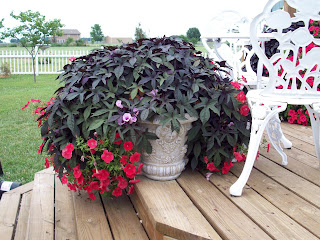 So goes it for the luxuriant upright elephant ears, the oxalis, the pineapple lilies, etc. After a few quick snips with the clippers, all are reduced to clumps of stubbly green stalks.
So goes it for the luxuriant upright elephant ears, the oxalis, the pineapple lilies, etc. After a few quick snips with the clippers, all are reduced to clumps of stubbly green stalks.Unfortunately, these tropicals and I are kindred spirits. We reside in a climate that forces us into a period of dormancy. Morose? Maybe a bit. Hopeful? Always. While I trade in my shorts, t-shirts, and flip flops for sweaters, jeans, and boots, my bulbs, tubers, and rhizomes trade their sunshine and rich soil for layers of mulch in containers that protect them from freezing. But, no matter how long this coming winters draws, inside there's still an energy quietly waiting to sprout forth into a new spring!
Money saving tip: Underneath all that lovely foliage of the ipomoea (Blackie, Marguerite, Ace of Spades-- just to name a few) is a wealth of potential new plantings for spring 2009. All summer long, those beautiful vines have been producing tubers beneath the soil. After I cut back the foliage, I carefully mine through the dirt and extract the potatoes. I never know what to expect to find and this year was no exception. One of my Marguerite vines produced a 6 lb, 2 oz tuber!!! After I've extracted all the tubers, I let them dry out for a few days in my laundry room and then I store them like any other bulb in the cool darkness of my garage. In late March, I pot the tubers and place them in a sunny window to get a head start on the planting season. It doesn't take long for the dormant tubers to wake up. As soon as there is a succession of nightly temperatures in the 50's, they are ready for outside planting.
Green tip: I particularly like to turn all the excess, non-woody foliage sheared from bulbs, tubers, and rhizomes into rich compost. I particularly like to compost elephant ear greenery. The high moisture content in the leaves and stalks is a plus in the compost bin.






Jennifer,
ReplyDeleteWAY KEWL!!!
Nice first post. I'm going to be looking for one daily!!! :-)
Mike
(David's good looking friend from work)
Mike,
ReplyDeleteAppreciate your kind words. I'm technologically challenged to say the least and I'm finding this a real adventure.
Jenn